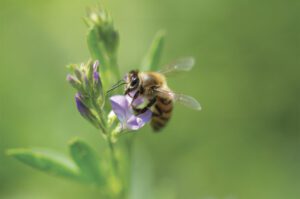It’s well known that pollinators, especially honeybees, play an important role in production agriculture for high-value fruits and vegetables.
But what is less known is their equally important impact on many forage crops.
The disruption of pollinator populations is a global concern. In rural areas, honeybees face a myriad of challenges including deadly pesticides, habitat loss, and lack of diverse food sources due to monocultures.
This creates a litany of stressors, including poor nutrition resulting from a lack of habitat and its diversity, lack of enough forage, and problems with pesticide exposures and diseases, according to entomology professors.
Today’s honeybees particularly struggle with additional challenges including pests, parasites, pathogens, and parasitic mites.
A lack of pollinators can decrease production and quality of several flowering forage products from season to season and year to year.
Fortunately, there are ways to strengthen and encourage these fragile populations, both domestic and native colonies, to enhance forages for grazing and harvesting.
Pollination stands as a cornerstone in the life cycle of numerous flowering crops, with forages like alfalfa, clover, and other legumes relying heavily on this process for their annual regrowth.
In this intricate web of pollination, both honeybees and solitary bees emerge as key players.
According to Christian Krupke, entomology professor, solitary bees are common residents in these fields, overwintering in the ground and covering shorter distances compared to honeybees.
Honeybees “are like the Swiss Army knife pollinators,” Krupke said. “That’s for two reasons. One, they have a colony of tens of thousands of individuals. That colony is pretty resilient, and they’re sending up massive numbers. No other pollinator competes with that in terms of volume of visits.”
Honeybees are also very adaptive and diverse in what they will forage on.
Krupke notes that being in close proximity to even just a few hives can definitely have a positive impact on the production of a pasture or hayfield.
“But by the same token, you can have a negative influence on honeybees too,” continued Krupke. “Doing things like spraying insecticides during the bloom period and the middle of the day are not best practices for pollinators.”
The influence pollinators have can also depend on their tendencies, such as if they travel long ranges or stay within a general area.
“Having said all that, it just makes it much more important that for producers who want to maximize the health and welfare of pollinators in those cropping systems.”
The alfalfa flower is especially vulnerable to lack of pollination. It must be cross-pollinated for best production and is almost entirely reliant on either honeybees or solitary bee varieties.
Because alfalfa is a multiyear variety that can be harvested for multiple years, Krupke points out that it takes time for the populations of pollinators to reach peak efficiency.
Achieving maximum effectiveness in pollination is not an overnight process, but rather a gradual progression spanning several years.
The influence of pollinators extends beyond alfalfa fields, making a notable impact on pastures and rangeland during grazing periods.
For honeybees, their pollination efforts not only contribute to robust proliferation but also intertwine with grazing practices to enhance pollinator habitats.
“If you let these supplemental forage and cover crops, like legumes, grow in these pastures or even native flowering habitats and ultimately rotate which plants the cattle are grazing on, you can not only provide roaming pastures for the cattle but also additional habitat for bees,” the entomologist said.
Forage producers hold the key to fostering thriving domestic and native honeybee communities while preserving their populations and enhancing their fields.
“Flowering cover crops, if they’re allowed to flower, are also great for pollinators because it provides them with pollen and nectar,” said Krupke.
“Even if a pesticide doesn’t kill, a sublethal dose may reduce the pollinator’s ability to perform routine tasks or to orient to pollen, nectar sources, and the colony. Exposing pollinators to sublethal levels of pesticides can also render them more susceptible to any of the other stress factors.”
Insecticides are stable in soil but are water-soluble and will move with water into plants, providing pest management benefits. These, however, also threaten pollinators in ways that older pesticide classes cannot.
There are newer technologies to spray the formulations or use safer formulations. Additionally, if beekeepers are informed beforehand, they can take preventative actions to move their colonies further from the treated fields to reduce the exposure.
In recent years, there have been greater strides in making a cognizant difference in maintaining and promoting pollinators where applicable and desired.
“There’s a lot more of an understanding not only of their importance but of how to keep their populations viable,” stated Krupke. “The one piece that I think there’s still room for improvement is that there is a disconnect when planting a pollinator strip or a meadow but keeping everything else the same. This is not the optimal way to help these populations.”
Providing a place that allows pollinators to not rely solely on a seasonal crop ensures positive nutrition for them, along with optimal area for foraging.
Likewise, having diverse flowering varieties enables honeybees and other pollinators to have forages available at various times and in between growing seasons throughout the year.
Another way farmers can help is through practicing crop rotation and inserting legumes into the rotation. This also enhances soil quality, thus also having a positive impact on plant growth.
“We know that bees are reliant on pollen and nectar of these plants. So, when bees are pollinating these crops and the crops are healthy, the pollen and nectar will be a great source for bees,” Krupke said.
“Farmers can also, if possible, allocate a tiny section of their land, maybe along the perimeter or along the margins, for supplemental forage along with the crops that they’re growing.”
+++30+++
